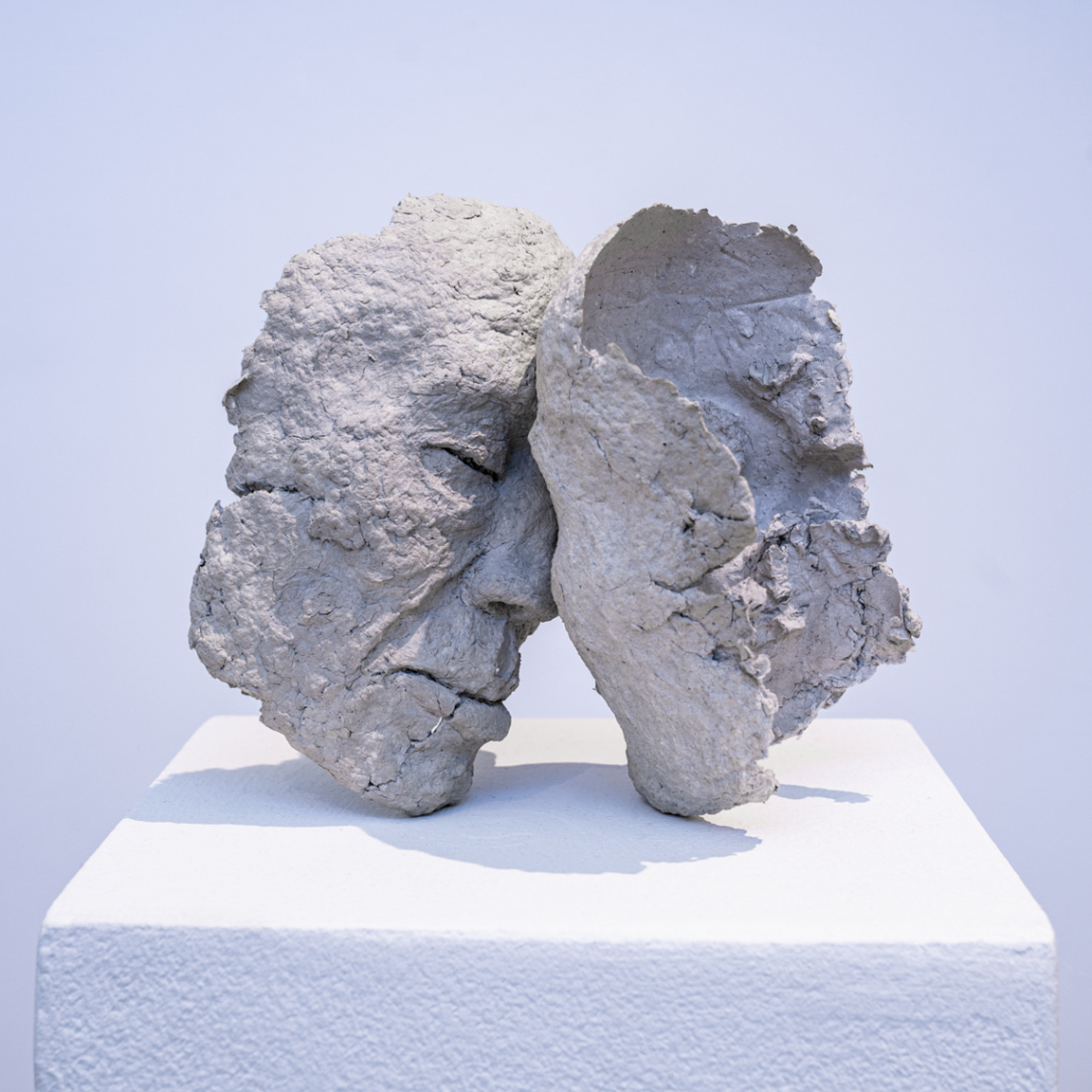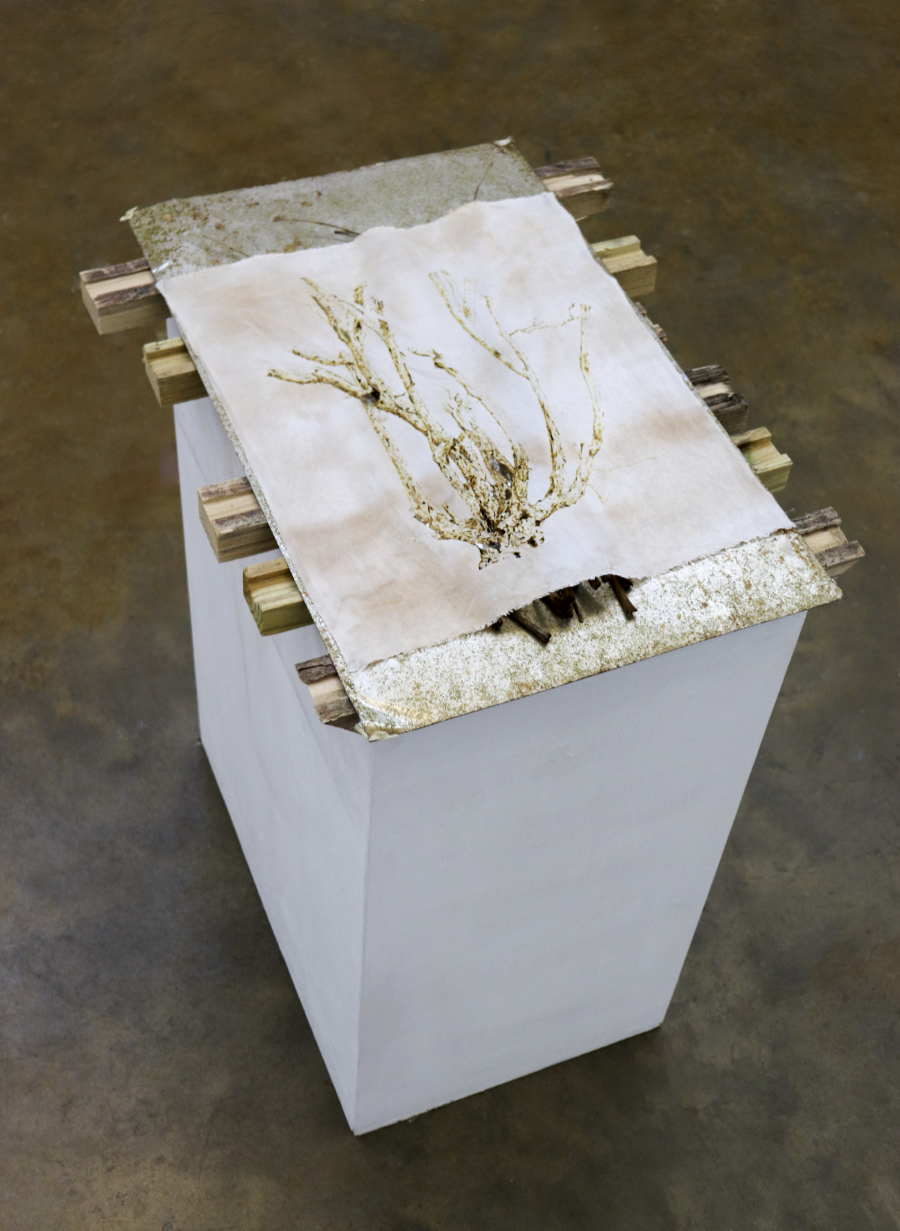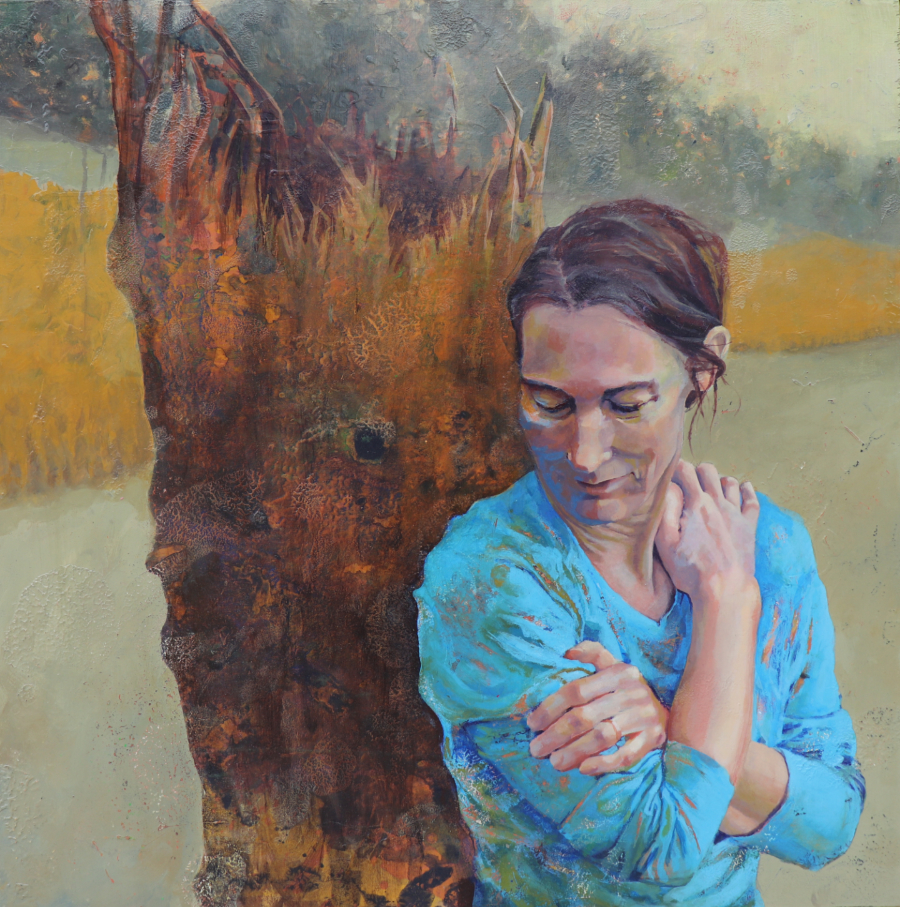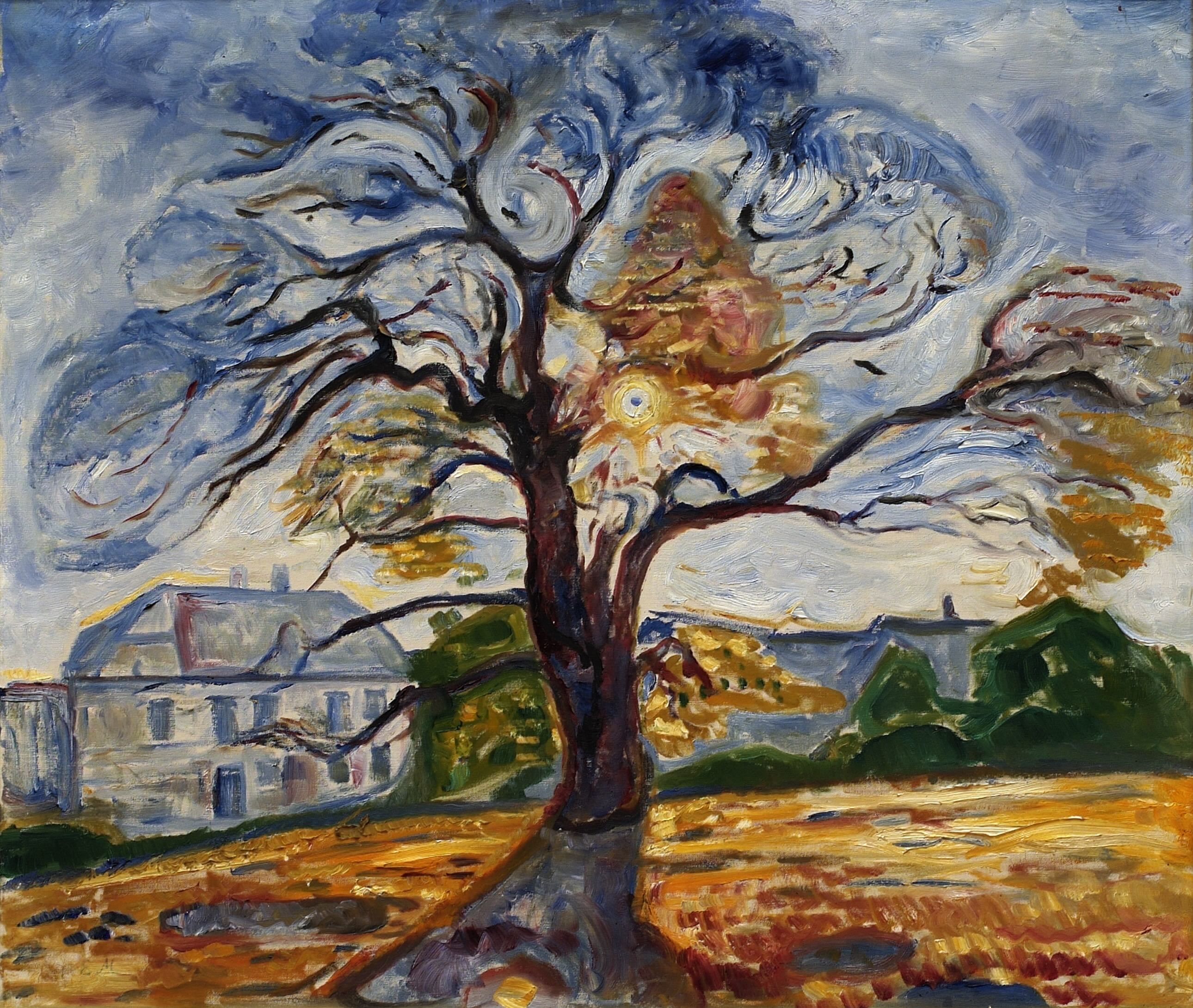Practicing Resurrection
Heading image: Edvard Munch (1863−1944), The Oak, 1906, oil on canvas, 85 x 100 cm. Public domain, via Wikimedia Commons.
A Note from IAMCultureCare
November always feels like a significant inflection month to me. At least where I’ve lived, in Chicago and now the east coast, November has no seasonal pretenses: It knows that autumn has arrived, that the harvest is gathered, and that we are swiftly approaching The End. Of course, our culture care communities in the southern hemisphere now entering their springtime may find this thought anachronistic. Yet November is a harbinger of change not just in the natural world but also economically, politically, and spiritually: Fiscal and calendar years draw to a close. There are more global political elections in late October and November than many other months combined. And, for Christians, the beginning of the month marks the ancient triduum of Allhallowtide — All Hallow’s Eve (or Halloween), All Saints’ Day, and All Souls’ Day — in remembrance of the departed and in acknowledgement of our own hastening mortality.
There’s a young silver maple outside my window. Tall, shapely, with a slight bow to the right, its form reflects more a suggestion of treeish symmetry than the rule. It’s flanked by two towering elder maples whose own wind-gnarled limbs predict the young tree’s future. It’s the first tree to change with the season, and I’ve watched captivated as the orange pigments slowly reveal themselves in retrograde photosynthesis. Each delicate appendage burns a rich copper and falls transfigured, surrendering to the will of wind and gravity. In an instant — no, in a leaf-strewn lawn full of instants — skeleton limbs are laid bare in anticipation. There is a deep magic here.
Google tells me I can measure the age of a silver maple by multiplying the diameter (measured at chest height) by three. I study the moss-splotched trunk, estimating. By my reckoning, a mere twenty years: a brief span even in human terms let alone a tree’s. But quantifying a life in this snapshot way feels wrong somehow. There is more to this maple, this Acer saccharinum, than meets the eye. Twenty years of hibernations — of waking to the drop, drop, drop of icicle-melt saturating deep-down roots, of quick, lively spring growth followed by hazy summer heat and cool autumns. Of wind and drought and rain, sun and weight of snow on bare limb. Of seedling, sapling, and seasoned maturation. Of decomposition. Of new life from death. This is the entish measure of a tree, of a season, of twenty. Perhaps too of a human life, of a culture.
I wonder whether the tree outside my office window is a portent for these quickening days. This November, I hope you find similar portals, similar abundant alternatives to measured scarcity. Some things — the most important, the most real, I guess — can’t be adequately summed up in a Google AI summary result, a cursory glance, and some mental math. But even trying to communicate this in prose runs up against the limits of language. Maybe this whole reflection would be better expressed in an attempt, however meager, at haiku:
a sudden wind-gust
whirling copper filigree—
another autumn
Jacob Beaird, Editor
A Note from Makoto Fujimura
I just spoke at Musashino Art University outside of Tokyo on my new book Art Is: A Journey into the Light (just released from Yale University Press). This was preceded by an interview with two wonderful authors at the Boston Book Festival. Soon, I will be back in US to speak at Yale University with poet Christian Wiman on this new book as well on November 17th. I am grateful for the many newsletter readers posting photos on social media of the book arriving in their hands. It is a beautiful book to behold (yes, get the physical book rather than Kindle or audio!).
Speaking to young Nihonga students and touring their studios made me reaffirm my conviction in writing this book. In these days of AI (see Jacob’s essay from the last newsletter) and digital fracturing and manipulation, the somatic knowledge of painting and making is critical to reconnect with our humanity. All education should point to the slow work of learning a craft, collaborating, and wrestling deeply with issues of art, faith, and culture.
The students asked many questions after my talk, and I was surprised at how many of their question — especially in this “secular” school — were about Jesus! One student confessed that he is a seeker and asked about my journey of faith and how can he deal with his doubts. This is what I remember saying to him:
Create knowing that God is the Artist. As you create, probe. Ask deeply. And make every stroke a prayer. God is already present in the work.
May our strokes, steps, and words ever more be vulnerable prayers. May our doubts be met by our Risen Christ who shows us his glorified wounds.
Yours for Culture Care,
Mako

Photo credit: Haejin Fujimura.
Meredith Tenney-Free: A Practice of Resurrection
Adapted from a speech given at Gordon College’s 2025 Graduation Luncheon
* * *
I said to my soul, be still, and wait without hope
For hope would be hope for the wrong thing; wait without love
For love would be love of the wrong thing; there is yet faith
But the faith and the love and the hope are all in the waiting.
Wait without thought, for you are not ready for thought:
So the darkness shall be the light, and the stillness the dancing.
Whisper of running streams, and winter lightning.
The wild thyme unseen and the wild strawberry,
The laughter in the garden, echoed ecstasy
Not lost, but requiring, pointing to the agony
Of death and birth.
- T.S. Eliot, “East Coker”, III, 123 – 133
“Hey Boo — Here’s a link to a famous Christian artist’s website. You can check out his work.”
My mom sent me this text message on May 23rd, 2013. I was sixteen years old, living far from the nexuses of culture in rural Ohio. The link sent me to Makoto Fujimura’s landing page. I explored every corner of his website. I read and reread, annotated and reannotated my copy of his book Refractions. Mako became my first artistic role model.
The next year, my mom heard that Mako’s collaborative exhibition based on T.S. Eliot’s Four Quartets was touring nearby — well, just an 8‑hour drive away, at Cairn University. There was also a public artist talk scheduled with the two visual artists in the exhibition: Mako and Bruce Herman. The only problem — the talk was tomorrow morning! Making a split-second decision, my mom and I hastily burned a CD audiobook of the Four Quartets, piled into the mini-van, and drove overnight to Philadelphia.
We arrived sleep deprived but steeped in Eliot. During the artist talk, I saw what I wanted to be when I grew up — an artist of excellence, fostering communal creativity, critical thinking, and cultural connection. That day altered the course of my life: I met two future mentors; I was pointed towards the college I would spend four generative years; and, though I wouldn’t realize it for a while, I was given a vocational benediction that galvanized the hardest years of my life.
In January of 2016, as I prepared for an admissions interview at Gordon College, my mother passed away suddenly from cancer complications. From the moment she died, Christ met me in beauty and sacredness. I watched the effects of death on her body — rigor mortis, growing cold, entombment — I saw Christ’s body in hers. That year I spent a lot of time with the resurrected Christ in the darkness of my mom’s grave.

Meredith Tenney-Free, Preserving, 2025, Recycled Paper, 8 x 8 x 7 in. Used with permission.
I came to Gordon that fall, grieving, but found great support in Bruce and friends I cherish to this day. I threw myself into my studies, exhibited in every show I could, and designed a degree tracing artistic motifs through time and culture. My junior year, I asked Bruce if he knew of any summer internship opportunities, only to be astonished when he recommended me to Mako. Weeks later, I was at “Fuji Farm” in Princeton NJ, making animal hide glue for Nihonga, assisting in gallery events, and picking chamomile blooms in Mako’s garden. I was in awe of the full circle journey; each day was a direct testament and result of my mother’s lingering care and support.
But truly, I hadn’t yet grasped what God was doing. As Eliot says, I “had the experience but missed the meaning.”
Recently, I found and rewatched Mako and Bruce’s 2013 artist talk and chapel address at Cairn. The message was one I’ve heard many times since I sat in the pews that day. The years of tutelage under Bruce and Mako have habituated me in the language of culture care, and in the traditions which weave into a vision of regeneration in Christ. However, something in the talk surprised me, something I did not remember, something which was more familiar to me than my own skin: a discussion of darkness, of death, of loss and grief and the artist’s task in it. In his address, Mako calls the artist to a practice of resurrection. The artist’s task is to first attune their work to describe the condition of darkness honestly, for all peoples. Then, the artist places firm signposts which point to the greater — beautiful — reality. Bruce described how “artists offer companionship through darkness which refuses a ready-made, easy answer, and instead brings you into the true virtue, the crucible which is surrender, saying with Christ: ‘Father into your hands I give my spirit.’”
At sixteen, I missed that message, but when my mom died, I lived it. I sat in the dark with Christ — waiting for the resurrection. Christ was the artist who companioned me in my mother’s death, and he led me to signposts of his reality when my reality fell apart. Several months after my mother died, I found a journal she began to write to me. One entry read:
“The Gordon application is half done. The art portfolio barely started…The weather is drifting towards late autumn — leaves are drifting also, from the refreshing calming cool of summer green to the shocked brilliance of fire and gold. It is beautiful the shades they turn in their final days. The trees shout out hope and color to us before they fall asleep — look at glory! Even in our “death” there is exquisite beauty and brightness!”

Meredith Tenney-Free, Shroud II, 2024, Burned silk, found metal, wood, and sumac branches, 28 x 18 x 3 in. Used with permission.
My mother ended this entry apologizing for the “esoteric thoughts that may be mostly unintelligible.” Yet, those words were prefigured, refracted in Mako’s and Bruce’s address at Cairn eleven years ago. After I graduated, those words inspired me to start a practice of bereavement portraiture — walking alongside families in grief, witnessing their darkness and pointing towards beauty. Today, her words still guide my graduate studies as I investigate the relationality between humans and nature in cycles of death, decay, and rebirth.
That day at Cairn I thought I saw what I wanted to be when I grew up. But God had planted a far deeper, interwinding, heartbreaking, vocation on my life: to practice resurrection — a vocation which Mako stated is “a difficult task, not for everyone, it’s a calling.” When resurrection is a practice, rather than a one-time event, we open the door for the spirit to move, for hope to rise, for the greater reality of heaven to press upon our brokenness.
In a world that is growing increasingly dark, may we all boldly claim a practice of resurrection.

Meredith Tenney-Free, Alicia, 2020, Acrylic on wood, 24 x 24 in. Used with permission.
Meredith Tenney-Free is a MFA candidate at Tyler School of Art and Architecture where she investigates the relationality between humans and the earth in experiences of grief. As part of her practice, Meredith partners with families to create bereavement portraits which capture the life, love, and loss of their loved one. Meredith has made a home in many locations, including rural Ohio, Jersey City, and Princeton, NJ, and the Boston Metro area. She is currently based in Bensalem, PA, with her spouse Wesley. Her work can be seen at her website and on IG @m.tenneyfree.
Dorella “Dee” Van Dyke (1952-2025)

Photo courtesy of Benjamin Zivan.
It is with heavy hearts that IAMCC announces the passing of Dee Van Dyke, whom many of our community from the early days of IAM will remember well. Her obituary follows.
* * *
It is said that an artist is someone who has a passion for creativity; whose work contributes to the beauty and diversity of our world; who is unafraid of failure; is adventurous and willing to step out of their comfort zone to create something that will transform their world; whose work speaks to others; who communicates through their art by translating what they see using their unique visual language; has deep appreciation for the talents of others and shares their time and resources with other artists; and — perhaps most importantly — who avoids over-explaining.
Dee was all of those things and more: a loving wife and supportive partner for 45 years to Jerry Zivan; mother to Benjamin Zivan; second mom to David Zivan and Jeff Zivan (Ann Carmen); grandmother to Sam and Jack; an especially loving aunt to her niece, Tish Thompson; and a true friend to many. She is also survived by her sister Phyllis Van Dyke Thompson (Tom), nephew Mark Thompson (Andrea), her aunt Bonnie Van Dyke and many Van Dyke first cousins.
Dee did not mince words when words were called for, but her preferred form of communication was through her art: painting, drawing, sculpture, and for the past several years through “The Contextual Table” — a communal dining experience that ‘brings art to dinner’ and people closer together.
Born in Atlanta in 1952, her childhood years were spent in Tazewell, VA, home of her father Ralph’s Van Dyke family, punctuated by summers and then her teenage years in Atlanta, home of her mother Dorothy’s Templeman family. Dee graduated from Westminster School in Atlanta and University of Georgia (B.A. in Fine Arts), followed by post-graduate work in NYC. She worked as a photographer’s stylist and gallery attendant in Atlanta during the day and painted at night. After spending a year living and studying in Aix-En-Provence, she returned to Atlanta in 1979 to devote herself full-time to her art and later on also worked with the art-therapy staff at Scottish Rite Children’s Hospital (now part of Children’s Hospital of Atlanta) and taught at what was then the Atlanta College of Art (now part of SCAD).
Dee moved with her family to Bluewater Bay in Northwest Florida in 1991; then spent a year with Jerry and Benjamin in Bozeman, MT in 1992 – 93, returning to Bluewater Bay, where she has lived for the past 32 years, and a full-time focus on her art.
She was the recipient of a National Endowment for the Arts fellowship and had her art exhibited in solo and group shows in New York City, Miami, Atlanta, Seaside FL and at several venues in Germany and elsewhere. Her work is in many individual and corporate collections.
Dee lived a full life; she left nothing undone; and she will be remembered for the beauty she brought into the world with her vision, with her art, with her tables, with her UGA dance steps, and for her faith in a better tomorrow.
A graveside service was held for Dee in Atlanta’s Greenwood Cemetery on September 30. In lieu of flowers, contributions in Dee’s memory may be made to either Children’s Healthcare of Atlanta, Atlanta, GA, Alaqua Pet Refuge, Freeport, FL, or by purchasing a work of art to support a local artist of your choosing.
Culture Care Events & Announcements
- “Dust and Gold — Makoto Fujimura & Shozo Michikawa” Exhibition—ALIEN ART CENTRE, Taiwan, September 28, 2025-August 30, 2026. Major works by Mako Fujimura are exhibited in dialogue with sculptor Shozo Michikawa in an expansive two-part exhibit — each part lasting six months — reflecting on time and impermanence. The first “Luminous Chapter” invites viewers to explore the question“How is light born?”, and to discover the potential for healing and renewal. The “Formative Chapter” (beginning in April) asks“How does force take shape?”, guiding viewers to explore the gestures behind the works and how time leaves its mark.
- “Art Is: A Journey Into the Light—What An Artist Sees” Lecture & Book Signing — Yale University, New Haven, CT, November 17 @ 5:30PM. Mako Fujimura in conversation with poet and essayist Christian Wiman about Fujimura’s new book, Art Is. Mako will speak about his writing and painting process based in his Princeton Studio. This free and open event is sponsored by the Yale Institute of Sacred Music Literature & Spirituality Program.
- “Do Science & Imagination Have Anything in Common?” Lecture & Book Signing, Makoto Fujimura and Kerry Magruder— Princeton, NJ, Dec 13 @2:00PM. What do science and the imagination share? Goldenwood Institute presents this conversation between Mako Fujimura and historian of science Kerry Magruder exploring how the history of scientific discovery — from early evangelical geologists to Charles Darwin — reveals a vision of the world shaped not by control, but by curiosity, faith, and awe. This event invites all — scientists, artists, theologians, and seekers alike — to join a dialogue at the intersection of faith, imagination, and the making of meaning. Registration required at the link above.
- Windrider Summit at Sundance — Park City, UT, January 25 – 30. Join the Windrider Institute in its annual Summit at the Sundance Film Festival. The Windrider Summit is a one-of-a-kind cultural experience. It is an opportunity to attend the premiere festival for independent films and interact with a community who shares a belief in the transformative power of story. It is also a chance to bring a distinctively spiritual and theological lens to film and explore some of the most important topics in our culture. Register at the link above.
- Culture Care: Reconnecting with Beauty for our Common Life 2nd edition to be published July, 2026. Mako Fujimura’s original Culture Care thesis is revised and expanded, featuring additional chapters on generative thinking and Culture Care as public theology, a new introduction, foreword and afterword, and fresh insights and stories of Culture Care in action from the years since the original 2017 publication. Available for pre-order now at the link above.
Do you have a news item or upcoming culture care event? Consider sharing it with us for a possible feature here in the newsletter! Email jacob@internationalartsmovement.org.
Web Links
- Latest Belonging Conversation from Mako Fujimura and Julia Hendrickson.
- New music recs: Swedish folk duo Väsen’s gorgeous new album Vågor (“Water”); Marc-André Hamelin plays prepared piano music by John Cage, Frank Zappa, and others.
- W. David O. Taylor’s great list of Advent resources.
- Ersun Augustinus Kayra on hospitality as infrastructure, for Plough.
- How to end an internet addiction.
- Mako Fujimura and Bruce Herman are interviewed by Peter Bouteneff for the Luminous podcast.
- Another recent Mako podcast: “The Church as an Artwork”, for Saturdays at Seven, with Todd Ream.
- Martin Shaw on the ancient vocation of storytelling.
- Mandolinist Chris Thile selects his favorite Nonesuch records.
- The Marginalian is 19 years old.
- Artist Flora Yukhnovich’s muralist homage to François Boucher’s Four Seasons, installed at The Frick.
- Mako Fujimura reflects on experiencing God through art, for Yale Press.
IAMCultureCare is a registered 501c(3) non-profit organization which relies on your support to continue our “Culture Care” work amending the soil of culture as an antidote to toxic culture wars. We welcome gifts of any size to continue these efforts. You can donate online or get in touch with us about corporate sponsorship and other giving methods!
All content in this newsletter belongs to the respective creators, as noted, and is used with permission. If you would like to submit something for consideration in a future newsletter issue, you may do so by filling out this form or by emailing jacob@internationalartsmovement.org.
